|
|
| |
|
|
| |
|
|
|
|
| |
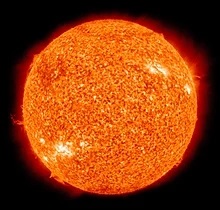 |
| False-color image
taken in 2010 as seen in ultraviolet light
(wavelength of 30.4 nm). |
Sun
The Sun is the star in the center of our solar system.
It is a yellow dwarf star. It gives off energy as light.
That includes light, infra-red energy (heat),
ultraviolet light and radio waves. It also gives off a
stream of particles, which reaches Earth as "solar
wind". The source of all this energy is nuclear fusion.
Nuclear fusion is the reaction in the star which turns
hydrogen into helium and makes huge amounts of energy.
The Sun is a star like many others in our Milky Way
galaxy. The Sun is a type of star called a G-type
main-sequence star based on its spectral class. It has
existed for a little over 4.5 billion years. It is going
to continue for at least as long. The Sun is about a
hundred times as wide as the Earth. It has a mass of
1.9891×1030 kg. This is 333,000 times the mass of the
Earth. 1.3 million Earths can fit inside the Sun.
The Sun fuses about 600 million tons of hydrogen into
helium every second. It can take between 10,000 and
170,000 years for the energy in the core of the Sun to
escape. |
|
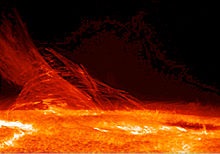 |
| Taken by Hinode's
Solar Optical Telescope on 12 January 2007, this
image of the Sun reveals the filamentary nature
of the plasma connecting regions of different
magnetic polarity. |
Origin
Scientists think that the Sun started from a very large
cloud of dust and small bits of ice about 4.567 billion
years ago.
At the center of that huge cloud, gravity caused the
material to build up into a ball. Once this got big
enough, the huge pressure inside started a fusion
reaction. The energy this released caused that ball to
heat and shine.
The energy radiated from the Sun pushed away the rest of
the cloud from itself, and the planets formed from the
rest of this cloud.
Composition
The Sun is mainly composed of hydrogen and helium. All
elements heavier than hydrogen and helium, accounts for
less than 2% of the mass of the Sun.
The Sun's chemical composition was gotten from the
interstellar medium. The hydrogen and most of the helium
in the Sun would have been produced by Big Bang
nucleosynthesis in the first 20 minutes of the universe.
The heavier elements were produced by stars that died
before the Sun was formed. The heavier elements were
released into the interstellar medium when the star
exploded as a supernovae.
Photosphere
This is the surface of the Sun. The light that the Earth
receives from the Sun is radiated from this layer. Below
this layer, the Sun is opaque, or not transparent to
light. |
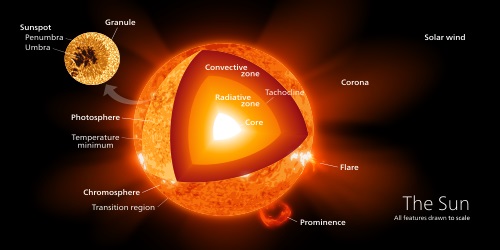 |
| The structure of the
Sun. |
Atmosphere
Five layers make up the atmosphere of the Sun. The
chromosphere, transition region, and corona are much
hotter than the outer photosphere surface of the Sun. It
is believed that Alfvén waves may pass through to heat
the corona.
The minimum temperature zone, the coolest layer of the
Sun, is about 500 kilometres (310 miles) above the
photosphere. It has a temperature of about 4,100 K
(3,830 °C; 6,920 °F). This part of the Sun is cool
enough to allow simple molecules such as carbon monoxide
and water to form. These molecules can be seen on the
Sun with special instruments called spectroscopes.
The chromosphere is the first layer of the Sun which can
be seen, especially during a solar eclipse when the moon
is covering most of the Sun and blocking the brightest
light.
The solar transition region is the part of the Sun's
atmosphere, between the chromosphere and outer part
called the corona. It can be seen from space using
telescopes that can sense ultraviolet light. The
transition is between two very different layers. In the
bottom part it touches the photosphere and gravity
shapes the features. At the top, the transition layer
touches the corona.
The corona is the outer atmosphere of the Sun and is
much bigger than the rest of the Sun. The corona
continuously expands into space forming the solar wind,
which fills all the Solar System. The average
temperature of the corona and solar wind is about
1,000,000–2,000,000 K (1,800,000–3,600,000 °F). In the
hottest regions it is 8,000,000–20,000,000 K
(14,400,000–36,000,000 °F). We do not understand why the
corona is so hot. It can be seen during a solar eclipse
or with an instrument called a coronagraph.
The heliosphere is the thin outer atmosphere of the Sun,
filled with the solar wind plasma. It extends out past
the orbit of Pluto to the heliopause, where it forms a
boundary where it collides with the interstellar medium. |
|
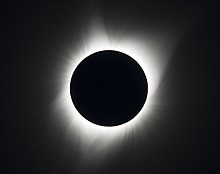 |
| During a total solar
eclipse, the solar corona can be seen with the
naked eye, during the brief period of totality. |
Visible features
Since the Sun is all gas, surface features come and go.
If the Sun is viewed through a special solar telescope,
dark areas called sunspots can be seen. These areas are
caused by the Sun's magnetic field. The sunspots only
look dark because the rest of the Sun is very bright.
Some space telescopes, including the ones that orbit the
Sun have seen huge arches of the Sun's matter extend
suddenly from the Sun. These are called solar
prominences. Solar prominences come in many different
shapes and sizes. Some of them are so large that the
Earth could fit inside of them, and a few are shaped
like hands. Solar flares also come and go.
Sunspots, prominences and flares become rare, and then
numerous, and then rare again, every 11 years.
Eclipses
A solar eclipse appears when the moon is between the
Earth and Sun. The last total solar eclipse occurred on
Dec. 26, 2019, and was visible from Saudi Arabia, India,
Sumatra and Borneo, with a partial eclipse visible in
Australia and much of Asia.
A lunar eclipse happens when the moon passes through the
shadow of the Earth which can only occur during a full
moon.The number of lunar eclipses in a single year can
range from 0 to 3. Partial eclipses slightly outnumber
total eclipses by 7 to 6. |
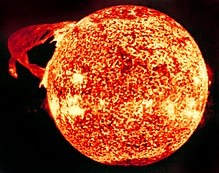 |
| 1973 Solar flare as
recorded by Skylab. |
Solar weather
Solar weather affects us on Earth. Solar weather (also
called space weather) includes sunlight and the solar
wind. Solar flares shoot a lot of very hot gas out from
the Sun. If a solar flare is aimed towards Earth,
protons — subatomic particles with positive electric
charge — can be shot at Earth at high speed, and a solar
storm could result. This could cause electrical
blackouts or block radio signals. It damages satellites
in orbit. Radiation from an extreme solar storm could be
very dangerous for astronauts, so they must be
protected. The Earth’s magnetic field and atmosphere
usually protect us from flares.
Solar flares can also cause an aurora. Auroras look like
beautiful curtains of shimmering light. They are called
Northern Lights (Aurora Borealis) if they are near the
North Pole. They are called Southern Lights (Aurora
Australis) if they are near the South Pole. Solar
weather affects other planets, too. We have pictures of
auroras on every planet except Mercury and Pluto.
Just like we can get Earth weather forecasts, we can get
Solar weather forecasts. Forecasters study the Sun to
figure out when flares will happen. They try to tell
when solar storms will hit Earth. They also try to tell
when solar storms will go to other parts of the Solar
System. |
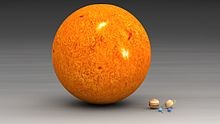 |
| Size comparison of
the Sun and its planets. |
Planetary system
The Sun has eight known planets. This includes four
terrestrial planets (Mercury, Venus, Earth, and Mars),
two gas giants (Jupiter and Saturn), and two ice giants
(Uranus and Neptune). The Solar System also has at least
five dwarf planets, an asteroid belt, numerous comets,
and a large number of icy bodies which lie beyond the
orbit of Neptune.
Observation and effects
Note: the following
information came from Kiddle.com....strongly
disagree....do not look directly into the sun under any
circumstances.
The brightness of the Sun can cause pain from looking at
it with the naked eye; however, doing so for brief
periods is not hazardous for normal non-dilated eyes.
Viewing the Sun through light-concentrating optics such
as binoculars may result in permanent damage to the
eyes.
Partial solar eclipses are hazardous to view because the
eye's pupil is not adapted to the unusually high visual
contrast.
Ultraviolet light from the Sun has antiseptic properties
and can be used to sanitize tools and water. It also
causes sunburn, and has other biological effects such as
the production of vitamin D and sun tanning.
Ultraviolet light is strongly reduced in force by
Earth's ozone layer, so that the amount of UV varies
greatly with latitude and has been partially responsible
for many biological adaptations, including variations in
human skin color in different regions of the Earth. |
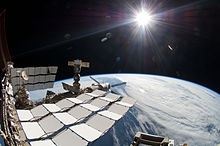 |
| The Sun, as seen
from low Earth orbit overlooking the
International Space Station. This sunlight is
not filtered by the lower atmosphere, which
blocks much of the solar spectrum. |
Exploration of the Sun
Early space probes designed to collect information about
the sun were NASA's Pioneers 5 through 9 and the Helios
1 and 2. Those were in the 1950s, 60s, and 70s. They
collected a lot of data about the Sun. The Parker Solar
Probe is a NASA robotic spacecraft launched in 2018 and
currently en route to probe the outer corona of the Sun.
It will approach to within 9.86 solar radii (6.9 million
kilometers or 4.3 million miles) from the center of the
Sun and by 2025 will travel, at closest approach, as
fast as 690,000 km/h (430,000 mph), or 0.064% the speed
of light.
The cost of the project is US$1.5 billion. Johns Hopkins
University Applied Physics Laboratory designed and built
the spacecraft, which was launched on August 12, 2018.
It became the first NASA spacecraft named after a living
person, honoring physicist Eugene Parker, professor
emeritus at the University of Chicago.
A memory card containing the names of over 1.1 million
people was mounted on a plaque and installed below the
spacecraft's high-gain antenna on May 18, 2018. The card
also contains photos of Parker and a copy of his 1958
scientific paper predicting important aspects of solar
physics.
On 29 October 2018 at about 1:04 p.m. EDT, the
spacecraft became the closest ever man-made object to
the Sun. The previous record, 26.55 million miles from
the Sun's surface, was set by the Helios 2 spacecraft in
April 1976. |
|
 |
| Halo with sun dogs. |
Fate of the Sun
Astrophysicists say our Sun is a G-type main-sequence
star in the middle of its life. In a billion years or
so, increased solar energy will boil away the Earth's
atmosphere and oceans. In a few more billion years, they
think the Sun will get bigger and become a red giant
star. The Sun would be up to 250 times its current size,
as big as 1.4 AU (210,000,000 kilometres; 130,000,000
miles) and will swallow up the Earth.
Earth's fate is still a bit of a mystery. In the long
term, the Earth's future depends on the Sun, and the Sun
is going to be fairly stable for the next 5 billion
years. Calculations suggest that the Earth might move to
a wider orbit. This is because about 30% of the Sun's
mass will blow away in the solar wind. However, in the
very long term the Earth will probably be destroyed as
the Sun increases in size. Stars like the Sun become red
giants at a later stage. The Sun will expand beyond
orbits of Mercury, Venus, and probably Earth. In any
event, the ocean and air would have vanished before the
Sun gets to that stage.
After the Sun reaches a point where it can no longer get
bigger, it will lose its layers and form a planetary
nebula. Eventually, the Sun will shrink into a white
dwarf. Then, over several hundred billion or even a
trillion years, the Sun would fade into a black dwarf. |
|
 Kiddle:
Sun Kiddle:
Sun
Wikipedia: Sun |
|
|
|
|
|
|
|
|
|
|
|
|
|
|
|
|
Search Fun Easy English |
|
|
|
|
|
|
|
|
|
|
|
|
|
|
|
About
Contact
Copyright
Resources
Site Map |